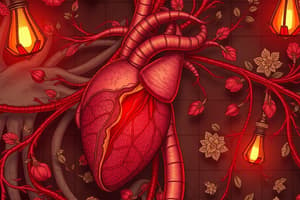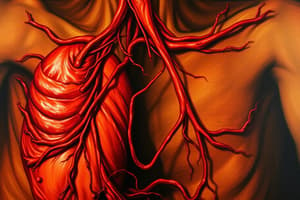Podcast
Questions and Answers
What is the primary function of the endothelial cells in normal hemostasis?
What is the primary function of the endothelial cells in normal hemostasis?
- Activate the coagulation cascade
- Maintain blood in a fluid state (correct)
- Promote clot formation
- Enhance platelet aggregation
Which of the following properties do endothelial cells exhibit under normal conditions?
Which of the following properties do endothelial cells exhibit under normal conditions?
- Thrombogenic activation
- Procoagulant properties
- Antiplatelet effects (correct)
- Increased clotting factors
How do endothelial cells respond after injury or activation?
How do endothelial cells respond after injury or activation?
- Increase antifibrinolytic activities
- Enhance blood flow
- Reduce platelet activation
- Exhibit procoagulant activities (correct)
What is the role of prostacyclin (PGI2) in hemostasis?
What is the role of prostacyclin (PGI2) in hemostasis?
What effect do heparin-like molecules have in hemostasis?
What effect do heparin-like molecules have in hemostasis?
What is the consequence of an intact endothelium in the circulation?
What is the consequence of an intact endothelium in the circulation?
What is the primary location for most superficial venous thrombi?
What is the primary location for most superficial venous thrombi?
Which type of venous thrombus is associated with higher risk of embolization?
Which type of venous thrombus is associated with higher risk of embolization?
What major condition is associated with the initiation of thromboses in atherosclerosis?
What major condition is associated with the initiation of thromboses in atherosclerosis?
What are the most common types of emboli that occur in thromboembolism?
What are the most common types of emboli that occur in thromboembolism?
What is the estimated annual death toll from pulmonary embolism in the United States?
What is the estimated annual death toll from pulmonary embolism in the United States?
Which condition can lead to the formation of atrial mural thrombi?
Which condition can lead to the formation of atrial mural thrombi?
What primarily facilitates platelet adhesion to the extracellular matrix?
What primarily facilitates platelet adhesion to the extracellular matrix?
Which substance activates the extrinsic clotting cascade when endothelial cells are stimulated?
Which substance activates the extrinsic clotting cascade when endothelial cells are stimulated?
What is the role of thrombin in platelet aggregation?
What is the role of thrombin in platelet aggregation?
Which components are released from dense granules during platelet activation?
Which components are released from dense granules during platelet activation?
What mechanism leads to the formation of an irreversible hemostatic plug?
What mechanism leads to the formation of an irreversible hemostatic plug?
Which factor stimulates platelet aggregation alongside ADP?
Which factor stimulates platelet aggregation alongside ADP?
What inhibits the activity of plasminogen activator in the hemostatic process?
What inhibits the activity of plasminogen activator in the hemostatic process?
What is the term for the initial, reversible aggregation of platelets?
What is the term for the initial, reversible aggregation of platelets?
What role does thrombin play in the coagulation process?
What role does thrombin play in the coagulation process?
What is the primary function of antithrombins in the coagulation cascade?
What is the primary function of antithrombins in the coagulation cascade?
How do Proteins C and S function within the coagulation cascade?
How do Proteins C and S function within the coagulation cascade?
What ultimately forms the secondary hemostatic plug?
What ultimately forms the secondary hemostatic plug?
Which substance is primarily responsible for moderating the size of the ultimate clot?
Which substance is primarily responsible for moderating the size of the ultimate clot?
What initiates the generation of plasmin in the coagulation process?
What initiates the generation of plasmin in the coagulation process?
What is the role of urokinase-like PA (u-PA) in fibrinolysis?
What is the role of urokinase-like PA (u-PA) in fibrinolysis?
Which natural anticoagulant complex is formed to prevent excess plasmin activity?
Which natural anticoagulant complex is formed to prevent excess plasmin activity?
What assay can be performed to assess coagulation?
What assay can be performed to assess coagulation?
What is the main outcome of the coagulation cascade?
What is the main outcome of the coagulation cascade?
Flashcards are hidden until you start studying
Study Notes
Hemodynamic Disorders, Thrombosis, and Shock
- Proper circulation is essential for delivering oxygen and removing waste from cells and tissues.
- Fluid homeostasis ensures blood remains liquid until clotting is necessary.
Hemostasis and Thrombosis
- Normal hemostasis involves regulated processes to keep blood fluid in vessels and quickly form clots at injury sites.
- Key components include the vascular wall, platelets, and the coagulation cascade.
Endothelial Cells
- Endothelial cells balance anti- and prothrombotic activities influencing thrombus formation.
- Under normal conditions, they exhibit antiplatelet, anticoagulant, and fibrinolytic properties.
- Endothelial injury leads to prothrombotic changes, facilitating platelet adhesion via von Willebrand factor (vWF).
Antithrombotic Properties
- Antiplatelet Effects: Inhibits platelet aggregation through prostacyclin (PGI2), nitric oxide, and adenosine diphosphatase.
- Anticoagulant Effects: Utilizes heparin-like molecules and thrombomodulin to prevent clotting.
- Fibrinolytic Effects: Involves tissue plasminogen activator (t-PA) to dissolve clots.
Prothrombotic Properties
- Endothelial injury increases platelet adhesion and activates the coagulation cascade, generating tissue factor in response to cytokines.
- Endothelial cells can also secrete plasminogen activator inhibitors (PAIs), limiting fibrinolysis.
Platelet Function
- Platelets are crucial in hemostasis, adhering to extracellular matrix through vWF.
- After adhesion, they release contents that increase surface expression of phospholipid complexes, promoting aggregation.
- Thrombin plays a key role in converting fibrinogen to fibrin, stabilizing the secondary hemostatic plug.
Coagulation Cascade
- Comprised of sequential proteolytic activations, culminating in thrombin production.
- Antithrombins, proteins C and S, and tissue factor pathway inhibitor (TFPI) control clot formation.
- Fibrinolysis is mediated by plasmin, which breaks down fibrin and is regulated to prevent excessive clot dissolution.
Thrombosis Types
- Venous Thrombosis: Especially prevalent in the legs; superficial thrombosis rarely embolizes, while deep vein thrombosis (DVT) poses serious risks of embolization.
- Cardiac and Arterial Thrombosis: Often associated with atherosclerosis and myocardial infarction, leading to mural thrombi.
Embolism
- An embolus is a mass that travels through blood vessels; most are thromboemboli.
- Can also include fat droplets, air bubbles, or foreign bodies, leading to ischemia in downstream tissues.
Pulmonary Thromboembolism
- Occurs in 20 to 25 of 100,000 hospitalized patients annually; causes around 200,000 deaths in the US.
- Originates predominantly from DVTs in the legs; can be asymptomatic or lead to sudden death if significant obstruction occurs.
Systemic Thromboembolism
- Refers to emboli in arterial circulation, mainly from cardiac sources, with common sites including lower extremities and brain.
Risk Factors for Deep Vein Thrombosis
- Immobility, pregnancy, post-surgical state, severe burns, heart failure, and disseminated cancer increase risk.
- High-risk patients need prophylaxis measures like heparin and mechanical leg compression.
Treatment of DVT
- Intravenous heparin and warfarin are standard treatment options.
Fat Embolism
- Occurs after long bone fractures or tissue trauma, leading to the entry of fat globules into circulation.
- Characterized by pulmonary insufficiency, neurological symptoms, and thrombocytopenia, with a fatality rate of about 10%.
Studying That Suits You
Use AI to generate personalized quizzes and flashcards to suit your learning preferences.




